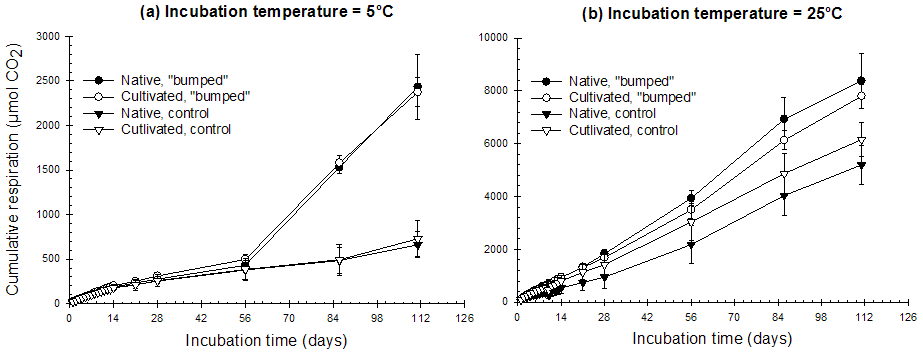
Saturday, 15 July 2006
138-16
Effect of Temperature on the Dynamics of Different Soil Organic Matter Fractions.
Michelle Haddix1, Megan Steinweg1, Richard Conant1, Alain Plante2, Eldor Paul1, and Johan Six3. (1) Natural Resource Ecology Lab, Colorado State Univ, Fort Collins, CO 80523-1499, (2) Villanova Univ, Dept of Biology, 800 Lancaster Avenue, Villanova, PA 19085, (3) Dept of Plant Sciences, Univ of California-Davis, One Shields Avenue, Davis, CA 95616
Soil C stocks are sensitive to changes in temperature and it is commonly believed that even minor increases in temperature may lead to large releases of C from soils to the atmosphere. Most of this thought is based on short-term incubation data and model output that implicitly assumes soil C pools are comprised of organic matter fractions with uniform temperature sensitivities. Some recent research suggests that labile and resistant soil C fractions may be equally sensitive to temperature, but other applicable research suggests that older, more resistant C fractions may be less temperature sensitive. We hypothesize that temperature sensitivity is inversely proportional to SOM turnover time, such that physical, chemical, and biochemical protection mechanisms act to reduce the temperature sensitivity of soil C, and that temperature-driven shifts in microbial community structure will impact soil C dynamics. An important corollary is that soil C stocks are less vulnerable to changes in temperature than previously supposed. We have devised three methods by which to test this hypothesis: by comparing respiration responses to different temperatures of (1) cultivated soils depleted in labile C versus those of native soils; (2) native vegetation-derived soil C with crop-derived soil C in cultivated systems by 13CO2; and (3) soil C depleted of labile soil C stocks following variable incubation duration. A novel method for testing our hypotheses is the inclusion of several temperature “bumps” during the long-term incubation, where the baseline incubation temperature is increased by 10°C (Fig 1). We will present results comparing native versus cultivated and native vegetation versus crop responses following 300 days of incubation and responses to temperature bumps at 60, 150, and 300 days. Preliminary results suggest that temperature sensitivity is large early in the incubation (mean = 6, range 3-11), that Q10 responses are largest for soils incubated at low temperatures (possibly due to greater abundance of labile C), and that responses do not differ between native and cultivated soils. Our expectations are that responses to the bumps, and Q10 values, will decrease as the incubation progresses, and during later bumps, as labile C is exhausted.
Back to 2.2A Soil Organic Matter: Stabilization and Carbon Sequestration - Poster
Back to WCSS
Back to The 18th World Congress of Soil Science (July 9-15, 2006)
